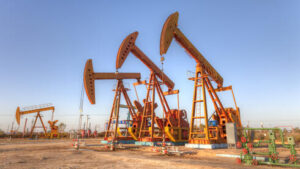
Oil continues to fall in price on Tuesday.
Traders are assessing the effects of Hurricane Beryl, which hit the Texas coast on Monday, and are following the negotiations between Israel and Hamas.
Expectations that the parties will agree on a ceasefire with the mediation of Qatar and Egypt are putting some pressure on the oil market, according to a review by the StoneX team of experts, as quoted by Market Watch. Analysts, however, note that “such negotiations have failed many times before.”
The cost of September futures for Brent on the London ICE Futures exchange as of 8:15 a.m. is $85.54 per barrel, which is $0.21 (0.24%) lower than at the close of the previous trading. On Monday, these contracts fell by $0.79 (0.9%) to $85.75 per barrel.
August futures for WTI in electronic trading on the New York Mercantile Exchange (NYMEX) fell by $0.22 (0.27%) to $82.11 per barrel by this time. As a result of the previous session, the value of these contracts decreased by $0.83 (1%) to $82.33 per barrel.
The effects of Hurricane Beryl were less severe than expected. However, some energy infrastructure facilities in Texas are still out of service due to the hurricane’s effects.
Traders’ attention this week is focused on the monthly reviews of the oil market by OPEC and the International Energy Agency.
In addition, the market is waiting for statements from Federal Reserve Chairman Jerome Powell, who will present a semi-annual report on monetary policy to the US Senate Banking Committee on Tuesday.

Benchmark oil prices are rising on Monday morning.
Quotes for September futures for Brent on the London ICE Futures exchange by 8:14 a.m. increased by $0.38 (0.45%) to $85.38 per barrel. On Friday, their price rose by $0.26 (0.3%) to reach $85 per barrel. August contracts, which expired at the end of the previous trading, rose in price by $0.02 to $86.41 per barrel.
August futures for WTI in electronic trading on the New York Mercantile Exchange (NYMEX) in the morning added $0.36 (0.44) to $81.9. On Friday, the value of these contracts decreased by $0.2 (0.2%) and amounted to $81.54 per barrel at the close of the session.
In June, Brent rose in price by 1.2%, WTI – by 5.9%.
The hurricane season has begun in the Atlantic, and traders are watching to see how it might affect oil trade in the US.
As Hurricane Beryl approaches the Caribbean from the southeast, it has strengthened to a category four, the Associated Press reports.
“This is a very dangerous situation,” the US National Hurricane Center (NRC) said. According to its forecasts, Beryl will cause a storm surge and pose a threat to life due to wind speed.

Oil prices are falling slightly on Friday after rising in the previous session due to data on the decline in US stocks.
Commercial oil inventories in the United States last week decreased by 2.55 million barrels, the country’s Energy Ministry said on Thursday. Commercial gasoline stocks fell by 2.28 million barrels, distillate stocks by 1.73 million barrels.
The cost of August futures for Brent on the London ICE Futures exchange as of 8:20 a.m. is $85.63 per barrel, which is $0.08 (0.09%) lower than at the close of the previous trading. On Thursday, these contracts rose in price by $0.64 (0.8%) to $85.71 per barrel, the highest since April 30.
Futures for WTI for August in electronic trading on the New York Mercantile Exchange (NYMEX) fell by $0.06 (0.07%) to $81.23 per barrel by this time. As a result of the previous session, the value of these contracts increased by $0.58 (0.7%) to $81.29 per barrel.
Since the beginning of this week, both Brent and WTI have risen in price by about 4%.
The oil market is supported by signals of growing demand for petroleum products in the country, in addition to data on declining stocks in the United States. According to the American Automobile Association, a record number of Americans will travel this year during the US Independence Day holidays.
“In general, the inventory data shows that the oil market is shrinking,” said Vivek Dhar, an analyst at Commonwealth Bank of Australia, as quoted by Bloomberg. – “The key risk that could lead to a decline in oil prices in the short term is the possibility of a weaker-than-expected increase in oil demand in China.

Oil prices are declining slightly on Tuesday after a 2 percent rise in the previous session amid a general increase in risk appetite in global markets.
The cost of August futures for Brent on the London ICE Futures exchange, as of 7:20 a.m., is $84.12 per barrel, which is $0.13 (0.15%) lower than at the close of the previous trading. On Monday, these contracts rose by $1.63 (2%) to $84.25 per barrel.
Futures for WTI for July in electronic trading on the New York Mercantile Exchange (NYMEX) fell by $0.16 (0.2%) to $80.17 per barrel. At the end of the previous session, the value of these contracts increased by $1.88 (2.4%) to $80.33 per barrel.
“Since mid-June, oil prices have been steadily rising on the back of US data,” said Fawad Razakzada, StoneX analyst. – “Last week’s market rise can be considered a delayed reaction to the OPEC+ decision to extend the current restrictions on oil production.
“Investors are also expecting fuel demand to increase with the start of the automotive season, which will push oil inventories lower in the coming weeks,” Razakzada said, as quoted by Market Watch.

Benchmark crude oil prices are declining on Friday after a weak rise the day before.
However, over the course of this week, they have gained more than 3% amid forecasts of stable global demand for fuel, Trading Economics writes.
Quotes for August futures for Brent on the London ICE Futures exchange at 7:52 a.m. decreased by $0.39 (0.5%) to $82.36 per barrel. On Thursday, these contracts rose by $0.15 (0.2%) to $82.75 per barrel.
The price of July futures for WTI on the New York Mercantile Exchange (NYMEX) fell by $0.45 (0.6%) to $78.17 per barrel in the morning. As a result of the previous trading, the value of these contracts increased by $0.12 (0.2%) to $78.62 per barrel.
Earlier this week, the US Department of Energy raised its forecast for global oil demand in 2024 by 140 thousand bpd to 102.98 million bpd. Thus, the agency expects that this year’s demand growth will be almost 1.1 million bpd, while a month earlier it was expected to be 920 thousand bpd.
OPEC still expects global oil demand to increase by 2.25 million barrels per day in 2024, and by 1.85 million bpd next year, according to the cartel’s June report.
Standard Chartered experts believe that global oil demand will increase by 1.68 million barrels per day this year and by 1.41 million bpd next year.

Prices for benchmark crude oil are slightly declining on Friday morning after falling during the previous session.
The cost of July futures for Brent on the London ICE Futures exchange as of 8:14 a.m. is $81.75 per barrel, which is 11 cents lower than at the close of the previous trading. On Thursday, these contracts fell by $1.74 (2.1%) to $81.86 per barrel.
Futures for WTI for July in electronic trading on the New York Mercantile Exchange (NYMEX) fell by $0.23 (0.3%) to $77.68 per barrel by this time. The day before, futures fell by $1.32 (1.7%) to $77.91 per barrel.
Pressure on the quotes was exerted by a general decline in investor interest in risky assets, which also led to a decline in US stock indices and an increase in US government bond yields.
“The US economy remains resilient, and inflation remains a concern. Under such conditions, the Federal Reserve has the ability to keep rates high for a long time, which is bad for oil demand forecasts and puts pressure on prices,” said Ricardo Evangelista, senior analyst at ActivTrades.
Even the data that commercial oil stocks in the US fell by 4.16 million barrels last week, while experts expected a decline of 1.15 million barrels, failed to support the market.
Meanwhile, gasoline stocks increased by 2.02 million barrels and distillate stocks by 2.54 million barrels. Analysts had forecast a decrease in gasoline stocks by 1.5 million barrels and the same level of distillate stocks.